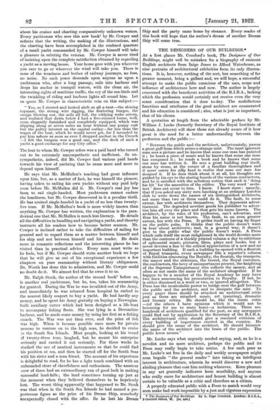THE DESIGNERS OF OUR BUILDINGS.* AT a first glance Mr.
Cornford's book, The Designers of Our Buildings, might well be mistaken for a biography of eminent English architects from Inigo Jones to Alfred Waterhouse, as nine portraits of architectural celebrities form its only illustra- tions. It is, however, nothing of the sort, but something of far greater moment, being a gallant and, we will hope, a successful attempt to make the public conscious of the uses, scope and influence of architecture here and now. The author is largely concerned with the beneficent activities of the R.I.B.A., lacking which the profession would certainly not receive even the very scant consideration that it does to-day. The multifarious functions and attributes of the good architect are enumerated and his education is considered ; also, what is just as important, that of his clients.
A quotation at length from the admirable preface by Mr. William J. Locke (formerly Secretary of the Royal Institute of British Architects) will show those not already aware of it how great is the need for a better understanding between the profession and the public :-
"Between the public and the architect, unfortunately, yawns a great gulf from which arises a strange mist. The most ignorant man sees a picture and he knows that some one man has painted it ; he hears a piece of music and he knows that some one man has composed it ; he reads a book and he knows that some one man has written it. He sees a great building rear itself, stone by stone, at the corner of a familiar thoroughfare and it never enters his silly head to realize that some one man has designed it. If he does think about it at all, his thoughts are guided by his eye to the staring boards of the various contractors, and he is satisfied with the nebulous notion that each is ` doing his bit' for the amenities of the edifice. The very word ' archi- tect ' does not occur to him. I know. I know more : namely, that if you asked any sixty men lunching at an ordinary London club to write down the names of six distinguished architects, not more than two or three could do it. The fault, to some extent, lies with architects themselves. They deprecate adver- tisement. The degraded novelist goads his publisher to adver- tise him all over the place and thus gets his name known. The architect, by the rules of his profession, can't advertise, and thus his name is not known. The fault, to an even greater extent, lies with the Press. It prides itself on having its finger on the public pulse. It thinks that the public doesn't want to hear about architects; and, in a general way, it doesn't give to the public what the public doesn't want. A Press which calls itself the most enlightened in the world devotes more than the contents of a thickly printed column a day to criticisms of ephemeral music, pictures, films, plays and books, but it never devotes a line to the critical appreciation of a new and an important building. If such a building be opened with a flourish of Royal trumpets, every newspaper fills a reporter's column with futilities concerning the Royalty, the flourish, the trumpets, the mayor and the aldermen, the trowel, the Royal costumes, the contractors, the bevy of unimportances present, the knighting of the Supreme Unimportancy who collects the money, and as often as not omits the name of the architect altogether. If he happen to be a member of the Royal Academy he may have two lines announcing his presentation to Royalty. If not, he is either dismissed in a word or two, or ignored altogether. The Press has the incalculable power to bridge over the gulf between the public and the architect, and to dissipate the mist. To every paper there should be attached an architectural critic just as there are attached music, art (painting), dramatic and literary critics. He should be, like the music critic —(of the others I have opinions which it would not be becoming for me to state here)—a technician. There are hundreds of architects qualified for the post, as any newspaper could find out by application to the Secretary of the R.I.B.A. The architectural critic should give e, reasoned criticism of every building of importance erected in the country. He should give the name of the architect. He should hammer the name of the architect into the brain of the public. The public loves names."
Mr. Locke says what urgently needed saying, and, as he is a novelist and no mere architect, perhaps the public and its Press may really begin to take notice. A few such pens as Mr. Locke's set free in the daily and weekly newspapers might soon beguile " the general reader " into taking an intelligent interest in architecture, wherein he would discover a new and abiding pleasure that cost him nothing whatever. Keen pleasure in any art generally indicates keen sensibility, and anyone who really cares for architecture and honest building is almost certain to be valuable as a critic and therefore as a oitizen.
A properly educated public with a Press to match would very soon make bad work impossible by a just and vigorous expression
.• The DesOtersof OurBuildings. By L, Cope Comford, London; IL,I.B.A4 9 Conduit Sheet WnOt.1
of praise or protest according to the merits or deficiencies of any new building.
Public opinion abolished slavery. Public opinion must abolish Pimlico.



































 Previous page
Previous page